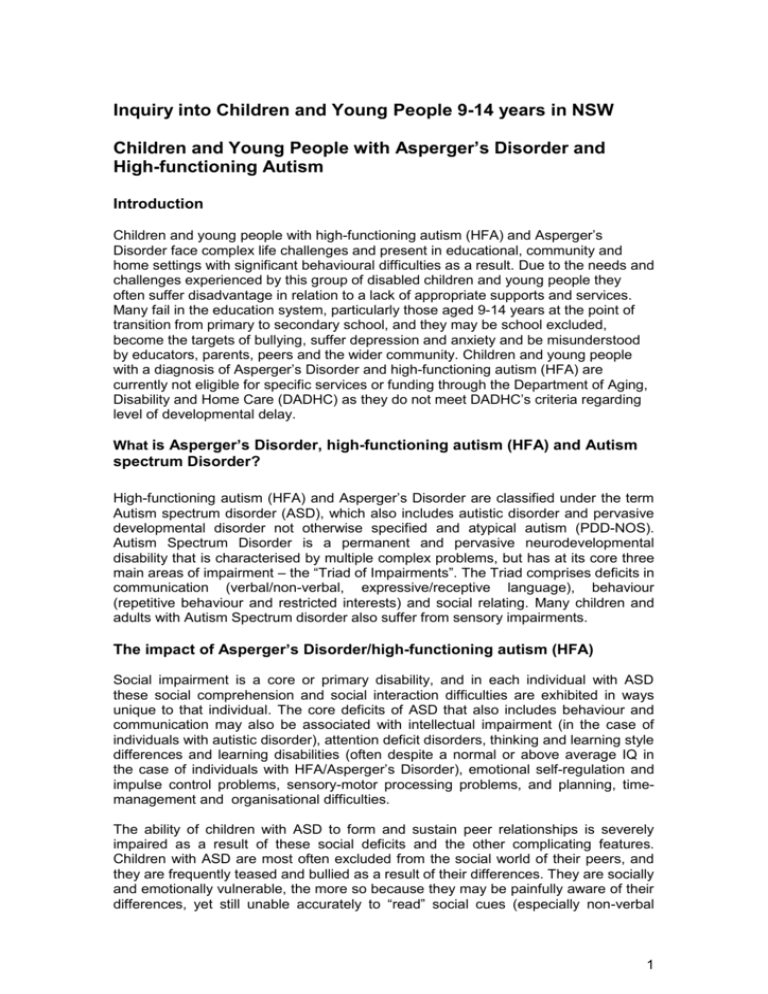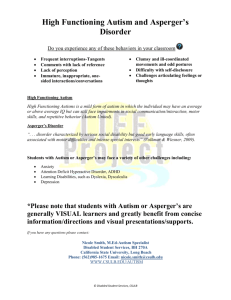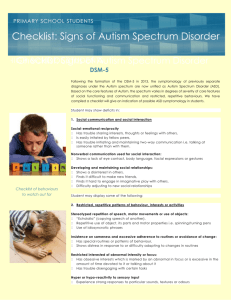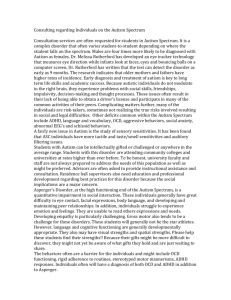Inquiry into Children and Young people 9
advertisement

Inquiry into Children and Young People 9-14 years in NSW Children and Young People with Asperger’s Disorder and High-functioning Autism Introduction Children and young people with high-functioning autism (HFA) and Asperger’s Disorder face complex life challenges and present in educational, community and home settings with significant behavioural difficulties as a result. Due to the needs and challenges experienced by this group of disabled children and young people they often suffer disadvantage in relation to a lack of appropriate supports and services. Many fail in the education system, particularly those aged 9-14 years at the point of transition from primary to secondary school, and they may be school excluded, become the targets of bullying, suffer depression and anxiety and be misunderstood by educators, parents, peers and the wider community. Children and young people with a diagnosis of Asperger’s Disorder and high-functioning autism (HFA) are currently not eligible for specific services or funding through the Department of Aging, Disability and Home Care (DADHC) as they do not meet DADHC’s criteria regarding level of developmental delay. What is Asperger’s Disorder, high-functioning autism (HFA) and Autism spectrum Disorder? High-functioning autism (HFA) and Asperger’s Disorder are classified under the term Autism spectrum disorder (ASD), which also includes autistic disorder and pervasive developmental disorder not otherwise specified and atypical autism (PDD-NOS). Autism Spectrum Disorder is a permanent and pervasive neurodevelopmental disability that is characterised by multiple complex problems, but has at its core three main areas of impairment – the “Triad of Impairments”. The Triad comprises deficits in communication (verbal/non-verbal, expressive/receptive language), behaviour (repetitive behaviour and restricted interests) and social relating. Many children and adults with Autism Spectrum disorder also suffer from sensory impairments. The impact of Asperger’s Disorder/high-functioning autism (HFA) Social impairment is a core or primary disability, and in each individual with ASD these social comprehension and social interaction difficulties are exhibited in ways unique to that individual. The core deficits of ASD that also includes behaviour and communication may also be associated with intellectual impairment (in the case of individuals with autistic disorder), attention deficit disorders, thinking and learning style differences and learning disabilities (often despite a normal or above average IQ in the case of individuals with HFA/Asperger’s Disorder), emotional self-regulation and impulse control problems, sensory-motor processing problems, and planning, timemanagement and organisational difficulties. The ability of children with ASD to form and sustain peer relationships is severely impaired as a result of these social deficits and the other complicating features. Children with ASD are most often excluded from the social world of their peers, and they are frequently teased and bullied as a result of their differences. They are socially and emotionally vulnerable, the more so because they may be painfully aware of their differences, yet still unable accurately to “read” social cues (especially non-verbal 1 communication) or social situations. They lack the necessary insight into themselves and others, and so they are unable to regulate their behaviour accordingly. They are unable to assess when interactions are failing, let alone “repair” situations if they do fail. To the casual observer, children and adolescents with HFA/Asperger’s, in particular may appear quite “capable” socially. Mainstream school teachers, for example, may assert, “There’s nothing wrong with the child. He is chatty and social, and spends the lunch break on the playground talking to me!” or, more often, “He’s a behaviour problem. He knows the rules, but playtime always ends in fights when he mixes with the other children!” Neither view takes into account the core social deficit in peer interactions that makes the playground so challenging for the young person. Similarly, in the wider community, for example at supermarkets, at the park, or at church, children and adolescents with HFA/Asperger’s disorder are often regarded with disapproval, and their parents may also have to endure pitying, or worse, critical looks and even open censure from strangers as a result of their child’s unusual or challenging behaviour. HFA/Asperger’s children and young people (and their parents) are misunderstood. Although these young people “look normal” in every respect, they may behave in ways that seem immature, rude, defiant, sullen, impertinent, or overly eager, persistent, or eccentric. All too frequently, adults personalise and blame these young people for inappropriate social behaviour, and peers reject, ostracise or bully them. Unlike their peers, who have at their disposal a sophisticated repertoire of social skills, young people with HFA/Asperger’s cannot quickly or flexibly “synchronise” their social information processing, their emotional state or their behaviour to respond appropriately to all the subtle, spontaneous and unpredictable peer interactions that take place in classrooms and on playgrounds. Similarly, they struggle to understand and respond appropriately in interactions that occur outside school, including with siblings and younger extended family members, neighbourhood playmates, or with team-mates at weekend sports. The impact of this almost universal misunderstanding and isolation on the emotional state of young people with HFA/Asperger’s cannot be underestimated. Most suffer from severe anxiety, social phobia and depression and are at heightened risk of selfharm and suicide. As a result of the complex nature of the social and emotional challenges faced by this group of 9-14 year olds with HFA and Asperger’s Disorder many display challenging behaviours as a response to unsupportive or even aversive conditions in educational and community settings. Unfortunately these behaviours often lead to school suspension and exclusion. The onset of puberty and the additional challenges of transition from primary to secondary years of schooling further compound the challenges faced by this group of disabled and disadvantaged students. For CALD and Aboriginal and Torres Strait Islander children and adolescents with ASD it could be argued that all the social difficulties, as well as the isolation and grief experienced by families, are further compounded by linguistic, cultural and racial issues. 2 Services and supports required The need for appropriate programs, services and resources is now especially relevant as recent research indicates that the number of children with ASD is rapidly increasing. In a study conducted in 2007 by the Australian Advisory Board on Autism Spectrum Disorders it was found that across Australia approximately 10,625 children (1 in 160) aged 6 to 12 have ASD. Statistics indicate that over the past six years the number of school students in integrated classes with ASD has significantly increased, on average, each year by approximately 27%. In 2001 there were approximately 1,200 school students with ASD who received support and in 2006 the number had increased to approximately 3,900. Many children and young people with HFA/Asperger’s disorder attend mainstream government and non-government schools throughout NSW. However, many are not receiving adequate support from teachers and support staff with the necessary knowledge and expertise in ASD. Some educational sectors provide specialist itinerant autism teachers and some autism-specific support classes. In spite of attempts by NSW Department of Education & Training, Catholic Education and Independent schools to support these students, Autism Spectrum Australia’s Educational Outreach service receives 100’s of requests for support for these students annually. Due to a lack of government funding, the Educational Outreach service is only able to offer a skeleton service currently to NSW schools. It should be noted that in recent community consultations in both the North Coast and Western Regions of NSW, students with HFA/Asperger’s disorder are identified as major priorities for increased support due to the issues outlined above. Autism Spectrum Australia recognises and strives to alleviate the many complex difficulties encountered by children and young people with ASD and their families and carers. In seeking to address these critical issues, Autism Spectrum Australia has developed a range of programs and services that are demonstrating positive outcomes for children and young people 9-14 years. They include: the provision of social skills and peer-support network programs, the Satellite Class program (Autism Spectrum Australia’s autism-specific classes of 5 to 6 students based in a mainstream school – infants to secondary ) and the itinerant Educational Outreach consultancy service. Demand for Autism Spectrum Australia’s social skills programs is high, with enquiries and requests from parents, school staff, health and allied health professionals, and from young adults with ASD themselves. Many more special educational options, including autism-specific intensive classes/provisions are required to adequately support this group. Other vital supports include; increased autism-specific itinerant services, social skills interventions including peer education, curriculum modifications, speech pathology, student welfare, counselling and mentoring programs, and transition to high school programs. Firstly however, Asperger’s Disorder and high-functioning autism must be recognised as a complex disability and thereby receive adequate and equitable funding at the level provided for other children and young people with autism across the spectrum. Conclusion The complex nature of Asperger’s Disorder and high-functioning autism (HFA) combined with the challenges of puberty, transition to high school and inadequate educational and community services and support make this group of 9 to 14 year old 3 children and young people amongst the most disadvantaged in New South Wales. This group is not eligible for funding support from several NSW government Department of Aging, Disability and Home Care (DADHC) as they do not meet criteria for developmental delay. The broadening of the criteria for existing funding and an associated increase in funding support will be necessary to address the educational and support needs of this group of disabled children and young people. Dr Trevor Clark Director, Education & Research Autism Spectrum Australia 29th April 2008 4








